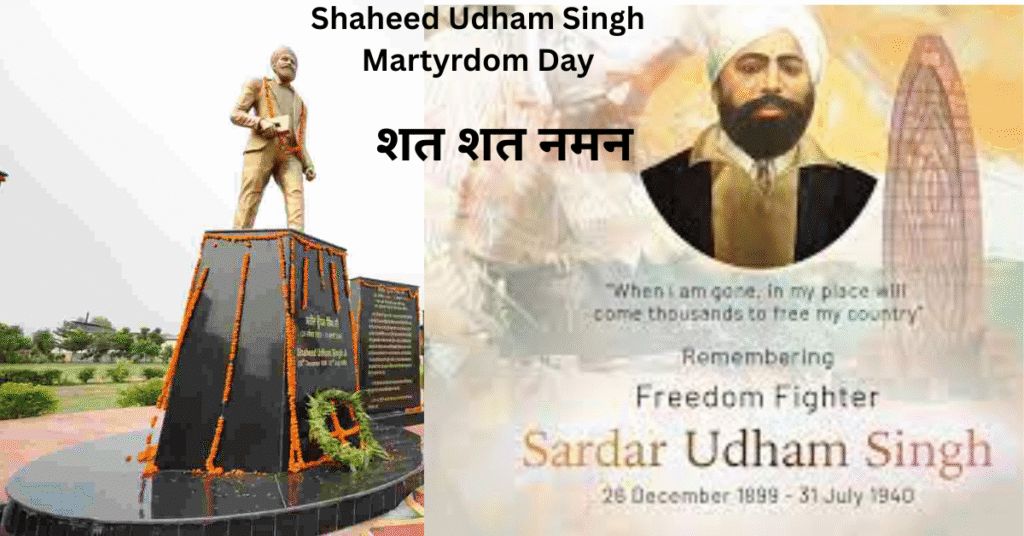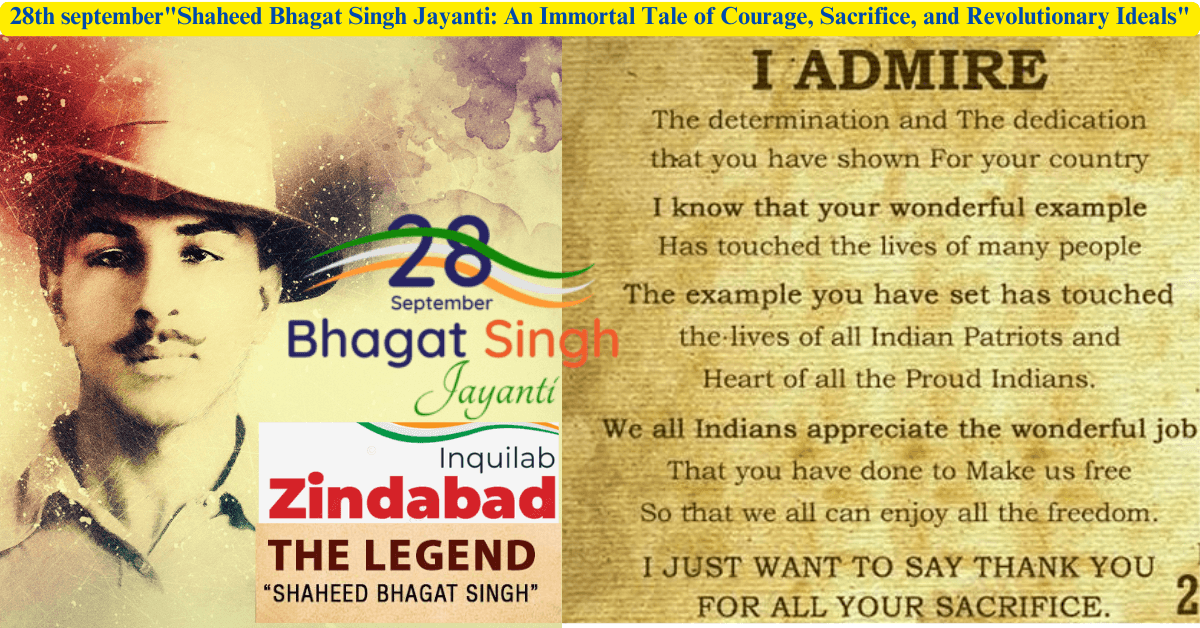
Table of Contents
Shaheed Udham Singh Martyrdom Day
Shaheed Udham Singh Martyrdom Day : Every year, July 31 is observed as Shaheed Udham Singh Martyrdom Day across India—a solemn occasion that commemorates the sacrifice of a revolutionary who etched his name in golden letters in the history of India’s freedom struggle. Though less celebrated than other national heroes, Udham Singh’s fearless act of avenging the Jallianwala Bagh massacre and his unwavering commitment to India’s independence makes him an enduring symbol of justice, patriotism, and resistance against imperialism.
This day is not just about remembering a man—it is about understanding his mission, honouring his ideals, and reigniting the spirit of selfless service for the nation.
Shaheed Udham Singh Martyrdom Day
Early Life of Udham Singh: Born in Struggles, Raised with Fire
- Birth and Childhood: Udham Singh was born on December 26, 1899, in Sunam, a small town in the Sangrur district of Punjab, then part of British India.
- Orphaned Early: He lost both his parents at an early age and was admitted to the Central Khalsa Orphanage in Amritsar, along with his elder brother.
- Exposure to Social Inequality: Living through poverty and orphanhood exposed him early to the harsh realities of colonial oppression and social injustice.
- Education: He completed his matriculation from the orphanage school and showed a keen interest in nationalist literature and the freedom movement.
Jallianwala Bagh Massacre: The Turning Point
The most defining moment of Udham Singh’s life came on April 13, 1919, when the Jallianwala Bagh massacre occurred.
- What Happened: On Baisakhi, thousands of unarmed Indians gathered at Jallianwala Bagh in Amritsar for a peaceful protest against the Rowlatt Act. British officer General Reginald Dyer ordered his troops to open fire without warning.
- Casualties: Over 1,000 people were killed, and thousands were injured in cold blood.
- Udham Singh’s Presence: He was present at the site and narrowly escaped death. This horrific incident left a deep psychological scar and ignited in him a lifelong determination to seek justice.
Shaheed Udham Singh Martyrdom Day
The Path of Revolution: From Punjab to London
After the massacre, Udham Singh became involved with revolutionary organisations such as:
- Ghadar Party: A prominent Indian revolutionary group active in the U.S. and Canada, aiming to overthrow British rule in India.
- Travels Abroad: To avoid British surveillance and gather international support, Udham Singh travelled through countries including the United States, Germany, the Soviet Union, and England.
- Aliases Used: He used several names during his revolutionary journey like Ram Mohammad Singh Azad, symbolising religious unity.
- Return to England: In 1934, he reached London and began preparations for avenging the Jallianwala Bagh massacre by targeting the man who sanctioned it—Michael O’Dwyer, the then Lieutenant Governor of Punjab.
The Assassination of Michael O’Dwyer: Justice Delivered
- Date of Assassination: March 13, 1940
- Location: Caxton Hall, London
- Target: Michael O’Dwyer, the architect and chief enabler of the Jallianwala massacre.
- How It Happened: During a joint meeting of the East India Association and the Royal Central Asian Society, Udham Singh smuggled a revolver into the hall and shot O’Dwyer twice at point-blank range.
- Motivation: The act was not mere revenge but a message to the British Empire that Indian blood was not cheap. He waited over 21 years to bring justice.
Trial and Execution: A Martyr’s Final Words
- Trial: Udham Singh was arrested immediately and put on trial at the Old Bailey Court in London.
- His Statement: When asked why he did it, he responded boldly: “I did it because I had a grudge against him. He deserved it. He was the real culprit… He wanted to crush the spirit of my people.”
- Execution Date: He was hanged on July 31, 1940, at Pentonville Prison in London.
- Age at Death: 40 years old
- Burial and Repatriation: For decades, his body lay in a British prison grave. In 1974, Udham Singh’s remains were brought back to India and cremated with full national honours in Sunam, Punjab.
Shaheed Udham Singh Martyrdom Day
Legacy and Commemoration in Modern India
State and National Recognition
- Statues and Memorials: Statues of Udham Singh stand tall in cities like Amritsar, Jalandhar, and Sunam.
- Institutions: Universities and public places have been named after him.
- Film and Culture: Bollywood films like “Shaheed Udham Singh” (1999) and “Sardar Udham” (2021) starring Vicky Kaushal have immortalised his story.
- Stamp and Currency: In 1999, India issued a postal stamp in his honour.
Annual Observances
- Punjab Government Events: Wreath-laying, candle marches, and patriotic events are held annually on July 31.
- Schools and Colleges: Host debates, speeches, and patriotic songs to honour Udham Singh’s sacrifice.
- National Tributes: Leaders from across political lines pay homage to his unmatched bravery and sacrifice.
Shaheed Udham Singh Martyrdom Day
The Message of Udham Singh: Why He Still Matters
1. A Symbol of Delayed but Determined Justice
He waited over two decades, crossing continents, adopting multiple identities, all for one just cause—justice for the lives lost at Jallianwala Bagh.
2. Unity Beyond Religion
His adopted name Ram Mohammad Singh Azad symbolised unity across Hindu, Muslim, and Sikh communities—a bold message during both colonial and postcolonial religious divisions.
3. Patriotism Beyond Borders
Udham Singh’s fight wasn’t limited to Indian soil. He internationalised India’s freedom struggle and exposed the brutality of British colonialism on global platforms.
#ShaheedUdhamSingh #MartyrdomDay #JallianwalaBagh #FreedomFighter #IndianIndependence #SardarUdham #July31 #UnsungHeroes #JusticeServed #IndianRevolution
Conclusion
Shaheed Udham Singh Martyrdom Day is a time to reflect, remember, and reignite the spirit of nationalism. He may have acted alone, but his sacrifice represents the collective outrage and resolve of millions of Indians oppressed under colonial rule.
As we enjoy the fruits of freedom, let us never forget the cost at which it came. Udham Singh did not die in vain. He lives on in every act of courage, every demand for justice, and every heartbeat that beats for a free and fair India.


